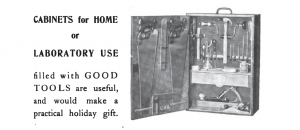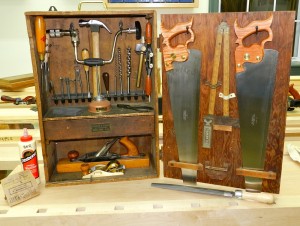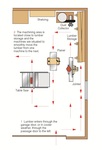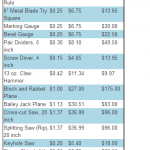We may receive a commission when you use our affiliate links. However, this does not impact our recommendations.
It’s Independence Day this week. Why not do something that makes you a little more independent in your tool-buying decisions?
In this guest perspective from Bill Rainford, traditional joiner, we learn a powerful method for analyzing today’s tool prices and thinking about which tools you really need in your shop. This article is about woodworking hand tools, but as someone who has visited Bill’s shop, I can tell you that he is no hand-tool purist. You’d love some of the machinery, new and old, he has acquired and cared for over the years.
For more depth on choosing the right tools, and especially using them, don’t miss Chris Schwarz’s new value pack – in stock today!
And for all of Bill’s posts in the Sloyd series, visit his blog! Thanks so much for this great post, Bill.
– Dan
 When I started out woodworking I’d watch television shows and read magazines pushing all kinds of fancy new tools and think “If only I had a shop full of those tools I could build anything.” I spent a long time saving my pennies, reading the reviews and trying out the latest tools. The models seemed to change with the seasons. New project? Time for a new bit, jig or gizmo. Realizing that earlier craftsmen didn’t have access to all of these modern wonders yet they produced far more intricate work, I began to approach woodworking by more ancient means.
When I started out woodworking I’d watch television shows and read magazines pushing all kinds of fancy new tools and think “If only I had a shop full of those tools I could build anything.” I spent a long time saving my pennies, reading the reviews and trying out the latest tools. The models seemed to change with the seasons. New project? Time for a new bit, jig or gizmo. Realizing that earlier craftsmen didn’t have access to all of these modern wonders yet they produced far more intricate work, I began to approach woodworking by more ancient means.
I quickly found that power equipment was not broadening my capabilities as much as it was like an anchor tethering me to a limited band of work and taking up valuable shop space. I also didn’t like wearing the requisite dust mask, hearing protection and safety glasses all the time – it was like a mini sensory deprivation chamber. When I asked master cabinetmaker Dan Faia what he does for dust protection in his own shop, his succinct reply was “I never coughed up a curl.” That pithy remark reflected the very different view traditional woodworkers have – without all the big machines, the dust and noise, you can focus on the work, invest in a smaller set of high quality tools that should last a lifetime and enjoy the process as much as the result.
If you are looking to downsize your powered shop, get into more traditional woodworking or if you’re just starting out the questions that often come up are: What is a good minimum set of tools I need to get started? How much is this all going to cost me?
In researching the Sloyd tool cabinet shown at left I found some old tool catalogs from Chandler & Barber of Boston (a primary supplier of Sloyd paraphernalia), including one from 1900 complete with a list of pricing for all the tools in the cabinet. This got me thinking. According to the Federal Reserve’s website, $1 in 1900 should be worth about $27 today. Yet a straight monetary conversion doesn’t paint a complete picture since some tools that were common back then are a specialty today, and vice versa. So I created a spreadsheet that includes columns for the original hand tool prices, those same prices adjusted for inflation and actual prices for similar tools from today’s retailers. Click here to see that spreadsheet.
In 1900, just as it was when I was a student over 100 years later, the view is that it is better to buy a quality tool once that will last a lifetime than buy something of poor quality which will not serve you well in your work. Keep that in mind as you review the list — since the tools were not the cheapest back then and surely are not the cheapest today. But with this modest set of tools you can build an amazing array of projects just as many ‘Sloyders’ (Sloyd school students) have done before us.
If your wallet still cringes at the totals above, fear not, for the totals above are for all brand new tools. The one luxury we have in our modern day of hand tools is the large secondhand market where you might be able to scoop up some great tools – possibly even some of the actual tools that once inhabited these cabinets – for the original price in today’s dollars, or less. So before you break out the barbeque, give some thought to how you can free yourself from a mountain of modern tools and invest in a modest set of traditional hand tools that will get you started on the path to more enjoyable woodworking.
Here are some supplies and tools we find essential in our everyday work around the shop. We may receive a commission from sales referred by our links; however, we have carefully selected these products for their usefulness and quality.












Very interesting data! And I have to acknowledge the diminishing return on machine tools and the accretive returns of hand tools. But I do woodworking as a beloved hobby. It is great to spend time creating a classic dovetailed drawer from quartersawn oak using hand tools. But I don’t want to use my limited time preparing rough-milled stock to workable dimensions. So, I’m blessed to have a tablesaw, a jointer, a planer, and a bandsaw as well.
Interesting numbers, Dan. Sometimes numbers alone do not tell the whole story, I think.
I do not have the appropriate comparisons to hand, but can you compare the price in 1900 vs. the price today of a loaf of bread, a sack of flour or a pint of beer? Or perhaps more simply, based on average wages of the day, how many jack planes could a worker buy with a day’s pay, vs how many jack planes could one buy with today’s wages?
Cheers, Ian
I have a theory that I call, “The Golfer’s Fallacy” It goes something like this, “If I only had that new putter [at $x] I could trim four strokes off my score.” And Abram’s corollary, “I really need “23 routahs; why change bits?”
No, sooner or later, the limiting factor is on the handle end of the tool. Reduces the workmanship of risk, perhaps, but still requires skill, dexterity, and care [David Pye]
I think this article has proven two things: the dollar has lost a tremendous amount of value, and tools are much more expensive than they used to be. Otherwise, I think the list is excellent and a woodworker with that tool set and a decent amount of skill would be able to build just about any ordinary piece of furniture or cabinet.
Thanks. You’ve just proved my theory that the base cost of any new pastime, whether it be hobby or sport, is $1,000.00!